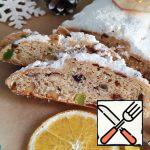Be prepared for the possibility that you might need more or less flour than specified in the recipe. Focus on achieving the desired consistency of the dough rather than fixating on the exact amount of flour.
Keep in mind that individual ovens may vary. The temperature and cooking time may deviate from those stated in the recipe.
It’s crucial to sift the flour to aerate it with oxygen. This step ensures that the baked goods turn out light and rise well during baking.
To melt butter in the microwave, cut it into small pieces and place it in a microwave-safe container. To prevent splattering during heating, cover the container with a paper towel. Melt the butter at the lowest power or in defrosting mode. Initially, five seconds may be sufficient. If the butter hasn’t melted, repeat the process in 5-second intervals until the desired result is achieved.
For melting butter using a water bath, you’ll need two containers of different diameters. Pour water into the larger container and place it on the stove. Position the smaller container on top, ensuring it is partially submerged in the water. Add the sliced butter to the smaller container. As the water boils, the butter will gradually melt. Stir the butter slightly to expedite the process. Once the butter pieces are completely dissolved, remove the container from the stove.
 Christmas Stollen Cottage Cheese Recipe
Christmas Stollen Cottage Cheese Recipe
 Classic Yeast Stollen Recipe
Classic Yeast Stollen Recipe
 Christmas Cake “Christmas Tree” Recipe
Christmas Cake “Christmas Tree” Recipe
 Cheese Stollen Recipe
Cheese Stollen Recipe
 Sponge Cake “Christmas Tree” with Marshmallows Recipe
Sponge Cake “Christmas Tree” with Marshmallows Recipe
 Christmas Pudding Recipe
Christmas Pudding Recipe
 Christmas Cookies Recipe
Christmas Cookies Recipe
 Christmas Cottage Cheese Non-Yeast Cupcake Recipe
Christmas Cottage Cheese Non-Yeast Cupcake Recipe
 Cake “Christmas Tree in the Snow” Recipe
Cake “Christmas Tree in the Snow” Recipe
 Christmas Wreath Cake Recipe
Christmas Wreath Cake Recipe
 Christmas Tree Meringue Cake with Tropical Kurd Recipe
Christmas Tree Meringue Cake with Tropical Kurd Recipe
 Christmas Cake with Dried Fruit Recipe
Christmas Cake with Dried Fruit Recipe